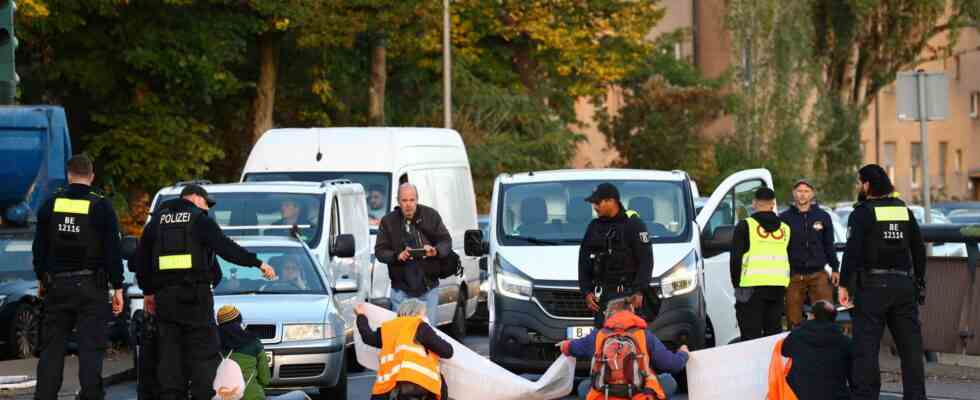FAQ
Status: 11/04/2022 2:36 p.m
After the accidental death of a cyclist in Berlin, the limits of the climate protest are discussed. Activists are accused of delaying the rescue operation. What does criminal law say?
The case
Last Monday morning, a cyclist was critically injured in a bicycle accident in Berlin-Wilmersdorf, and the woman has since died. According to the fire department, she was trapped under a cement mixer. The rescue workers on site had requested a rescue vehicle with special tools to free them. However, the journey to the scene of the accident was delayed because of a traffic jam on the A100 city motorway – “by several minutes”.
According to the Berlin police, climate activists had put up posters on a sign bridge over the street and then taped themselves. In order to take them away from there, the police temporarily blocked two out of three lanes of the highway. There was already a traffic jam when the fire engine drove onto the A100. There are almost four kilometers of road between there and the site of the protest. From the place of protest to the scene of the accident you drive another four and a half kilometers.
After the incident, there were increasing calls for the activists to be held criminally responsible. But which criminal offenses are considered?
Negligent homicide?
After the first reports, many people thought: Were the activists to blame for the cyclist’s death? According to Section 222 of the Criminal Code (StGB), anyone who causes the death of a person through negligence is liable to prosecution. In principle, negligent homicide is also possible if you did not hit the cyclist yourself.
But: It is not automatic. One of the prerequisites would be: You would have to prove that the protesters delayed the rescue operation with their action and that the woman died because the fire brigade did not get to her quickly enough with the special equipment. So, to put it simply, you have to be able to attribute the death to the activists. The exact circumstances of the case, which are now being further determined, are decisive for this. There are no final answers yet.
Disability of persons providing assistance?
But there are also paragraphs that do not refer directly to the dead cyclist, but only punish helpers if they are disabled. According to paragraph 323 c paragraph 2 of the Criminal Code, anyone who, in the event of an accident or common danger or need, hinders a person who is helping a third party or who wants to help is also punished. This rule has only been in place for a few years. It pursues the goal that helpful people can help undisturbed, regardless of whether they are private first aiders or rescue workers.
There is a violation of this rule here. The investigators, or courts, must first clarify whether the blockade led to the fire brigade being obstructed a few kilometers away. And second, whether the activists had the necessary intent. Did they at least accept the fact that they hinder people who want to help?
Disabling professional helpers with violence or threats?
There is also a somewhat more specific provision that punishes using violence to obstruct professional helpers (Section 115 (3) of the Criminal Code). Specifically, there is talk of those providing help “from the fire brigade, civil protection or an emergency service”. The legislator originally thought of cases in which, for example, rescue workers are physically attacked or physically detained at the scene of an accident. The Higher Regional Court of Hamm, for example, convicted a man who placed his car in the way of an accident as a kind of physical obstacle and did not drive away, so that the ambulance did not come directly to the accident. Whether this paragraph can be relevant in the specific case would still have to be checked.
Coercion?
In the past few months, there have already been convictions for coercion in the Berlin courts due to road blockades (Section 240 of the Criminal Code). In legal terms, coercion means forcing an action or omission against the will of the victim, for example through violence. The mere presence of demonstrators on the road may block the first car, but does not constitute violence in legal terms.
But the courts have long been saying: The first car that has to stop blocks all other cars behind it and their drivers. This can also include the fire brigade in a specific case. But that’s not enough to make it punishable. The courts must expressly weigh up the means and ends, taking into account, for example, the fundamental right to freedom of assembly. Factors such as the duration and intensity of the blockage are also important. So it depends on the circumstances in the specific case.
What does the fine depend on?
For each of the offenses described, the Criminal Code specifies a range of penalties within which the penalty can vary. Negligent homicide, for example, is punished “with a prison sentence of up to five years or a fine,” coercion “with a prison sentence of up to three years or a fine,” and obstructing people providing assistance with “a prison sentence of up to one year or a fine.”
Merely citing maximum penalties does not help, however, because they are rarely imposed in practice. In each specific case, the courts examine, for example: Has someone committed a crime for the first time, or is it a repeat offender? What else speaks for and against him or her? After that, and depending on the offence, a decision is made as to whether a fine, imprisonment with or without probation will be imposed.


